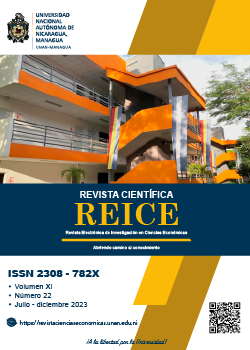Gestión óptima del capital circulante: equilibrio entre liquidez y rentabilidad en la gestión financiera
DOI:
https://doi.org/10.5377/reice.v11i22.17342Palabras clave:
Gestión del Capital de Trabajo, Liquidez, RentabilidadResumen
Este artículo ofrece un examen exhaustivo de la importancia de la gestión del capital circulante en el ámbito de la gestión financiera. Este documento examina la importancia del capital de trabajo en el sostenimiento de las operaciones de una empresa y su papel en la facilitación del éxito empresarial. La investigación también subraya la diferenciación entre capital circulante bruto y neto, así como las características de la gestión del capital circulante, con especial atención a la interconexión entre activos y pasivos corrientes. El estudio tiene como objetivo evaluar la situación financiera de la empresa azucarera y ofrecer información sobre su eficiencia operativa y sostenibilidad financiera a largo plazo. Los autores también han destacado la necesidad de realizar este estudio en el marco de la situación económica de la India tras la liberalización. La sección de metodología de la investigación dilucida los orígenes de los datos primarios y secundarios empleados en el estudio, ofreciendo así transparencia en el proceso de recolección de datos. El estudio proporcionó un análisis de varios ratios financieras relacionados con la liquidez, la rotación de existencias, la rentabilidad del período de tenencia, los cambios en las existencias y la rotación de los deudores. Los autores han llevado a cabo un análisis exhaustivo de los ratios a lo largo de varios años, proporcionando información significativa sobre el rendimiento financiero de la empresa azucarera. Los hallazgos han llamado la atención sobre aspectos importantes, incluida la dependencia de la empresa de fuentes de financiamiento a corto plazo y el impacto sustancial de las existencias y varios deudores en el capital de trabajo bruto. El análisis también ha puesto de manifiesto la adherencia de la empresa a los ratios actuales y rápidos aceptables, las fluctuaciones en el ratio de líquido absoluto, así como las oscilaciones en la rotación de inventarios y los ratios de rotación de deudores. La sección de ideas ofrece consejos prácticos para la organización, que abarcan el mantenimiento de los procesos de gestión del capital de trabajo existentes, la mejora de la gestión del inventario y la gestión eficaz de los flujos de caja. En conclusión, se resume sucintamente la importancia de la gestión del capital circulante, con especial énfasis en su papel fundamental para mejorar el rendimiento empresarial, fomentar el crecimiento y facilitar la modernización. El artículo de estudio presenta un examen exhaustivo de la gestión del capital de trabajo de la empresa azucarera y ofrece información significativa para la toma de decisiones financieras de la empresa.
Descargas
1296
Citas
Akbar, A., Akbar, M., Nazir, M., Poulova, P., & Ray, S. (2021). Does working capital management influence operating and market risk of firms?. Risks, 9(11), 201.
Appuhami, B. (2008). The Impact of Firms' Capital Expenditure on Working Capital Management: An Empirical Study across Industries in Thailand. International management review, 4(1).
Dash, M., & Ravipati, R. (2009). A liquidity-profitability trade-off model for working capital management. Available at SSRN 1408722.
Forghani, M., Shirazipour, M., & Hosseini, A. (2013). Impact of working capital management on firms performance. Journal of Basic and Applied Scientific Research, 3(7), 943-947.
Nazir, M. S., & Afza, T. (2009). Impact of Aggressive Working Capital Management Policy on Firms' Profitability. IUP Journal of Applied Finance, 15(8).
Padachi, K. (2006). Trends in working capital management and its impact on firms’ performance: an analysis of Mauritian small manufacturing firms. International Review of business research papers, 2(2), 45-58.
Palombini, N. V. N., & Nakamura, W. T. (2012). Key factors in working capital management in the Brazilian market. Revista de Administração de Empresas, 52, 55-69.
Pass, C. L., & Pike, R. H. (1984). An overview of working capital management and corporate financing. Managerial Finance, 10(3), 1-11.
Smith, K. V. (1973). State of the art of working capital management. Financial management, 50-55.
Uremadu, S. O., Egbide, B. C., & Enyi, P. E. (2012). Working capital management, liquidity and corporate profitability among quoted firms in Nigeria: Evidence from the productive sector. International journal of academic research in accounting, finance and management sciences, 2(1), 80-97.
Zariyawati, M. A., Annuar, M. N., Taufiq, H., & Rahim, A. A. (2009). Working capital management and corporate performance: Case of Malaysia. Journal of Modern Accounting and Auditing, 5(11), 47.

Descargas
Publicado
Cómo citar
Número
Sección
Licencia
Derechos de autor 2023 REICE: Revista Electrónica de Investigación en Ciencias Económicas

Esta obra está bajo una licencia internacional Creative Commons Atribución-NoComercial-CompartirIgual 4.0.
Copyright (c) Revista Electronica de Investigacion en Ciencias Economicas
Los derechos sobre los artículos publicados en REICE son de la revista, a los efectos de poder gestionar su mejor difusión. No obstante, puesto que la finalidad de la misma es la difusión del conocimiento, esta revista provee acceso libre inmediato a su contenido, bajo el principio de que hacer disponible gratuitamente la investigación al público, lo cual fomenta un mayor intercambio de conocimiento global.
Las opiniones expresadas por los autores no necesariamente reflejan la postura de la editora de la publicación ni de la UNAN-Managua Se autoriza su reproducción y distribución (en cualquier tipo de soporte) siempre que se cumpla las siguientes indicaciones:
- La autoría del trabajo
- Que se indique su origen (revista REICE, volumen, número y dirección electrónica del documento)
